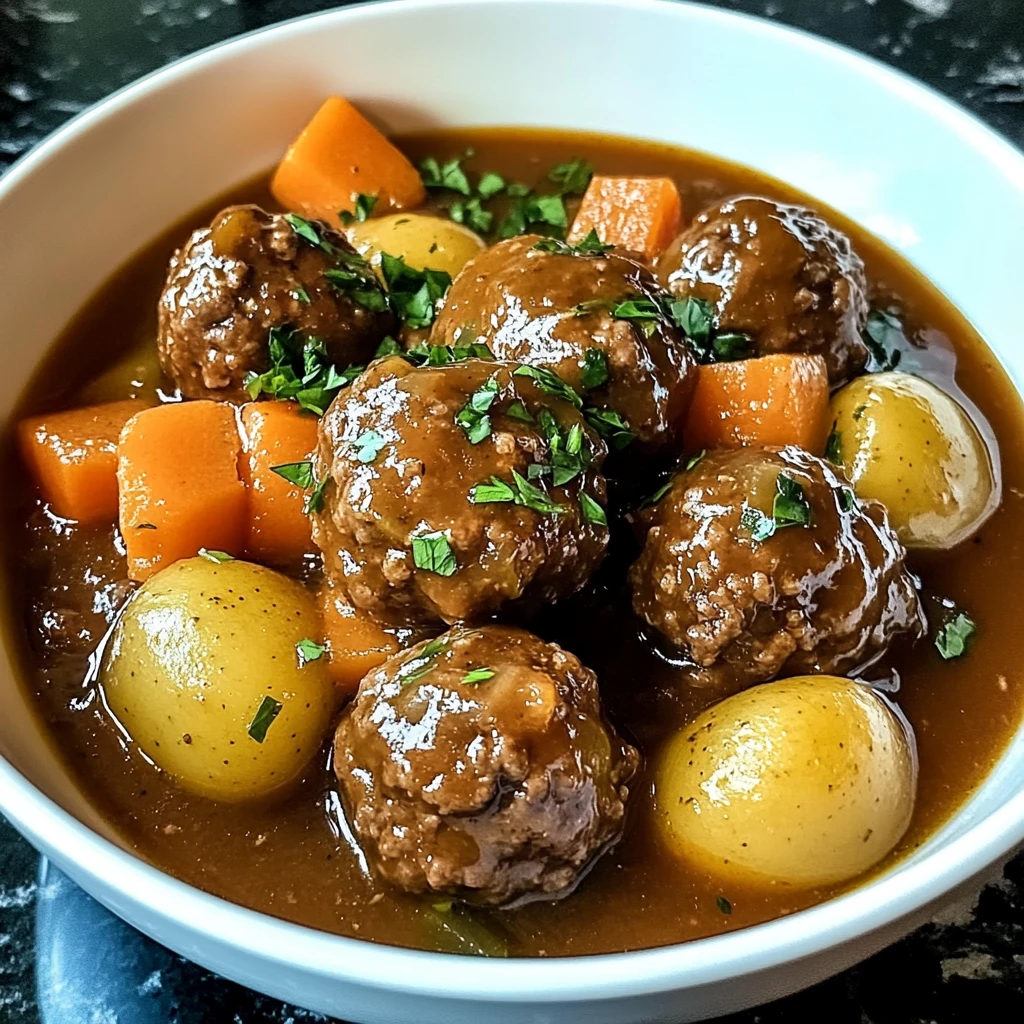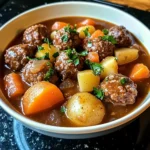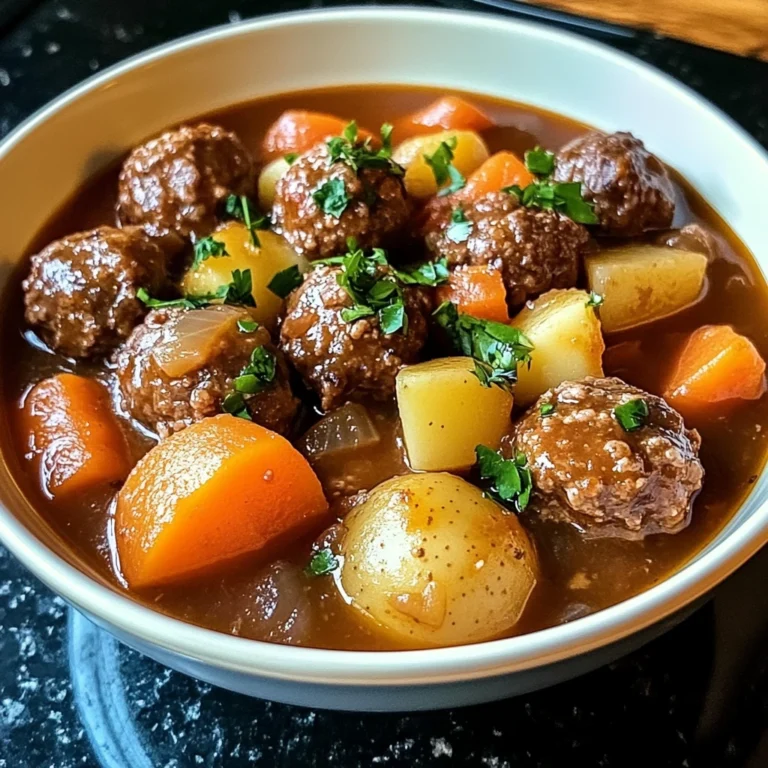In the heart of Ireland, where the rolling green hills and cozy pubs beckon, there’s a dish that captures the very essence of the Emerald Isle – Irish Meatball Stew. This hearty, soul-warming creation is a beloved tradition, passed down through generations and cherished as a true taste of Irish culinary heritage.
Table of Contents
At its core, Irish Meatball Stew is a comforting blend of tender meatballs, simmered in a rich, savory broth alongside an array of wholesome vegetables. Each bite is a delightful symphony of flavors, with the juicy meatballs and tender potatoes, carrots, and peas creating a harmonious dance on the palate. It’s a dish that embodies the simplicity and authenticity that make Irish cuisine so beloved around the world.
Ingredients for Authentic Irish Meatball Stew
To recreate this Irish Meatball Stew masterpiece in your own kitchen, you’ll need a carefully curated selection of ingredients:
- 1 pound ground beef
- 1 pound ground lamb
- 1 cup breadcrumbs
- 1/4 cup chopped fresh parsley
- 1/4 cup grated Parmesan cheese
- 1 large egg
- 2 cloves garlic, minced
- 1 teaspoon salt
- 1/2 teaspoon black pepper
- 1 tablespoon Worcestershire sauce
- 1 tablespoon olive oil
- 1 large onion, diced
- 4 carrots, sliced
- 4 potatoes, diced
- 4 cups beef broth
- 1 tablespoon tomato paste
- 1 teaspoon dried thyme
- 1 teaspoon dried rosemary
- 1 cup frozen peas
The key to this Irish Meatball Stew is the perfect balance of ingredients. The ground beef and lamb provide a rich, meaty flavor, while the breadcrumbs, parsley, and Parmesan add depth and texture to the meatballs. The array of vegetables – from the earthy potatoes to the sweet peas – creates a well-rounded and satisfying dish.
Step-by-Step Guide to Crafting Irish Meatball Stew
Ready to embark on your Irish Meatball Stew adventure? Follow these simple steps to create a masterpiece in your own kitchen:
Prepare the Meatballs
In a large bowl, combine the ground beef, ground lamb, breadcrumbs, parsley, Parmesan, egg, garlic, salt, and pepper. Mix well until all the ingredients are evenly incorporated. Shape the mixture into small, bite-sized meatballs.
Brown the Meatballs
Heat the olive oil in a large pot or Dutch oven over medium heat. Add the meatballs and brown them on all sides, about 2-3 minutes per side. Once browned, remove the meatballs from the pot and set them aside.</
Sauté the Vegetables
In the same pot, add the diced onion, sliced carrots, and diced potatoes. Sauté the vegetables for 5-6 minutes, or until they begin to soften.</
Add Broth and Seasonings
Stir in the tomato paste, dried thyme, dried rosemary, and beef broth. Bring the mixture to a simmer.
Simmer the Stew
Return the browned meatballs to the pot, cover, and let the stew simmer for 30-35 minutes, or until the potatoes are tender and the meatballs are cooked through.
Finish with Peas
In the final 5 minutes of simmering, stir in the frozen peas to allow them to warm through.
Serve and Enjoy
Ladle the Irish Meatball Stew into bowls and savor the comforting flavors of this timeless Irish classic. Pair it with a crusty loaf of bread for a truly satisfying meal.

The Nutritional Value of Irish Meatball Stew
Not only is Irish Meatball Stew a delicious and satisfying dish, but it also boasts impressive nutritional value. The lean ground beef and lamb provide a generous amount of protein, while the array of vegetables – from the potatoes and carrots to the peas – offer a wealth of essential vitamins, minerals, and fiber. This hearty stew can be enjoyed as part of a balanced diet, making it a comforting and wholesome choice for any occasion.
Variations on the Classic Irish Meatball Stew
While the traditional Irish Meatball Stew is a beloved classic, there are countless ways to put your own spin on this timeless dish. You can experiment with different types of meat, such as turkey or chicken, for a leaner alternative. Vegetarian and vegan adaptations are also possible, using plant-based protein sources like lentils or mushrooms in place of the meat.
Flavor variations can also be explored, with the addition of various herbs, spices, or even a touch of Irish whiskey for a unique twist. Seasonal produce can also be incorporated, such as using root vegetables in the winter or incorporating fresh herbs and greens in the spring and summer.
Serving Suggestions and Pairings for Irish Meatball Stew
The best way to enjoy Irish Meatball Stew is with a hearty, crusty bread for sopping up every last drop of the delicious broth. A simple green salad or a side of roasted vegetables can also complement the stew perfectly. For those seeking a more indulgent pairing, a creamy mashed potato or a side of buttered noodles can elevate the dish to new heights.
When it comes to beverages, a glass of robust Irish stout or a crisp Irish lager can provide the perfect accompaniment to this comforting stew. For a non-alcoholic option, a warm, freshly brewed cup of Irish breakfast tea or a cozy mug of hot apple cider can be equally delightful.
FAQs About Irish Meatball Stew
What makes Irish stew different from regular stew?
The key difference between Irish stew and a regular stew is the use of lamb as the primary meat. Irish stew traditionally features lamb, which gives it a distinctive flavor profile compared to stews made with beef or other meats. Additionally, Irish stew often includes potatoes, onions, and other root vegetables, creating a heartier, more rustic dish.
What are the 4 ingredients in Irish stew?
The four main ingredients in a traditional Irish stew are lamb, potatoes, onions, and carrots. These ingredients form the backbone of the dish, with the lamb providing the rich, savory base, and the vegetables adding texture and flavor.
What is a traditional Irish stew called?
A traditional Irish stew is simply referred to as “Irish stew.” It is a beloved and iconic dish in Irish cuisine, made with the humble yet flavorful ingredients that have sustained the Irish people for generations.
What is the best meat for Irish stew?
The best meat for Irish stew is traditionally lamb, which is considered the most authentic choice. Lamb provides a robust, gamey flavor that pairs perfectly with the other ingredients in the stew. However, beef can also be used as a substitute, and many modern variations of Irish stew feature a combination of both lamb and beef.
More Related Recipes You Might Enjoy
- Creamy Mozzarella Chicken Linguine with Garlic Cajun Butter
- One-Pot Creamy Cajun Meatball Pasta
- Spinach Garlic Meatballs Stuffed with Mozzarella
Conclusion: A Taste of Ireland in Every Bite
When you sit down to a steaming bowl of Irish Meatball Stew, you’re not just enjoying a delicious meal – you’re experiencing a piece of Ireland’s rich culinary heritage. This comforting dish is a testament to the simple, wholesome flavors that have nourished the Irish people for generations. Whether you’re craving a cozy winter meal or seeking a taste of the Emerald Isle, Irish Meatball Stew is sure to warm your soul and bring a smile to your face. So gather your loved ones, fire up the stove, and let the aroma of this timeless classic fill your kitchen. Sláinte!
For more snack ideas and kitchen inspiration, follow me on Pinterest.
Print
Create a Hearty Irish Meatball Stew for a Cozy Dinner Night
- Prep Time: 20 minutes
- Cook Time: 40 minutes
- Total Time: 1 hour
- Yield: 6 servings 1x
- Category: Main Course
- Method: Stovetop
- Cuisine: Irish
Description
Savory Irish Meatball Stew: A Comforting Classic
Ingredients
- 1 pound ground beef
- 1 pound ground lamb
- 1 cup breadcrumbs
- 1/4 cup chopped fresh parsley
- 1/4 cup grated Parmesan cheese
- 1 large egg
- 2 cloves garlic, minced
- 1 teaspoon salt
- 1/2 teaspoon black pepper
- 1 tablespoon Worcestershire sauce
- 1 tablespoon olive oil
- 1 large onion, diced
- 4 carrots, sliced
- 4 potatoes, diced
- 4 cup beef broth
- 1 tablespoon tomato paste
- 1 teaspoon dried thyme
- 1 teaspoon dried rosemary
- 1 cup frozen peas
Instructions
1. Prepare the Meatballs: In a large bowl, combine the ground beef, ground lamb, breadcrumbs, parsley, Parmesan, egg, garlic, salt, and pepper. Mix well until all the ingredients are evenly incorporated. Shape the mixture into small, bite-sized meatballs.
2. Brown the Meatballs: Heat the olive oil in a large pot or Dutch oven over medium heat. Add the meatballs and brown them on all sides, about 2-3 minutes per side. Once browned, remove the meatballs from the pot and set them aside.
3. Sauté the Vegetables: In the same pot, add the diced onion, sliced carrots, and diced potatoes. Sauté the vegetables for 5-6 minutes, or until they begin to soften.
4. Add Broth and Seasonings: Stir in the tomato paste, dried thyme, dried rosemary, and beef broth. Bring the mixture to a simmer.
5. Simmer the Stew: Return the browned meatballs to the pot, cover, and let the stew simmer for 30-35 minutes, or until the potatoes are tender and the meatballs are cooked through.
6. Finish with Peas: In the final 5 minutes of simmering, stir in the frozen peas to allow them to warm through.
7. Serve and Enjoy: Ladle the Irish Meatball Stew into bowls and savor the comforting flavors of this timeless Irish classic. Pair it with a crusty loaf of bread for a truly satisfying meal.
Notes
The key to this Irish Meatball Stew is the perfect balance of ingredients. The ground beef and lamb provide a rich, meaty flavor, while the breadcrumbs, parsley, and Parmesan add depth and texture to the meatballs. The array of vegetables – from the earthy potatoes to the sweet peas – creates a well-rounded and satisfying dish.
Nutrition
- Serving Size: 1 bowl
- Calories: 450
- Sugar: 3g
- Sodium: 800mg
- Fat: 25g
- Saturated Fat: 10g
- Unsaturated Fat: 15g
- Trans Fat: 0g
- Carbohydrates: 30g
- Fiber: 5g
- Protein: 30g
- Cholesterol: 90mg

